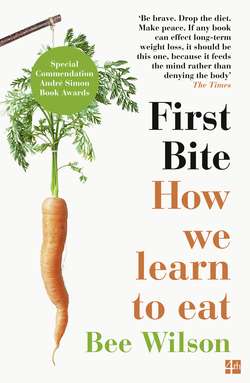Читать книгу First Bite: How We Learn to Eat - Bee Wilson - Страница 9
BEETROOT
ОглавлениеEvery culture seems to have certain challenging vegetables that children find hard to love at first bite. And at second. And third. In Brazil, it is okra (the sliminess). In France, it may be turnips (the bitterness). In lots of countries, it is beetroot (the purpleness).
There are plenty of reasons to find beetroot off-putting. There’s the curious taste, reminiscent of earth and blood (the culprit is a chemical compound called geosmin). Also, the texture, which in its cooked form is neither crunchy nor soft but fleshy. Most of all, there is the shocking colour that bleeds inescapably over everything on your plate.
Yet among sophisticated adult eaters, beetroot is often a special favourite. It thus offers a case study in how we can learn new tastes. It’s not just that people learn to tolerate beetroot: they switch from dislike to adoration. Since the 1990s beetroot has been a beloved item on restaurant menus, often paired with goat’s cheese. Adult beet lovers enjoy the very qualities that children find so awful: the earthy taste and meaty texture and, most of all, the bright crimson pigment, which can dye a whole pan of risotto a joyous pink.
Between the beet haters and the lovers, there is a gulf. Some of it can be explained – as with many other dislikes – by the form in which we first encounter the outlandish purple vegetable. Childhood memories of vinegary pickled beetroot do not help. When someone learns to love beetroot, it is often because they have been given a taste of these roots in a new and more appealing form, when eating out: a fresh and vibrant beet and orange salad, say, or a moreish deep-fried beetroot crisp.
Regardless of cooking method, however, there does seem to be something in strong vegetable flavours such as beetroot that people take longer to hit it off with. In one study, seven- and eight-year-old children from the Netherlands were given tastes of pure beetroot juice every day for fourteen days, the kind of ‘exposure’ that in theory should lead to liking. But at the end of the fortnight, they continued to find the beetroot taste ‘too intense’.72
Maybe it is the sense of achievement at having conquered an aversion that makes adult beetroot fans flaunt their enjoyment so overtly. Foodies trumpet their love of the hated vegetables of childhood: cauliflower and Brussels sprouts join beetroot as dinner party favourites. But beetroot eaters are not just showing off. It is possible to reach the point where these complex, bitter flavours deliver more pleasure than the simple blandness of mashed potato.
The psychologist E.P. Köster has shown that one of the beneficial effects when children are exposed through ‘sensory education’ to a wider range of flavours is that they start to love complexity and be bored by simplicity.73 Given time and enough attempts, we actively seek out those foods – like beetroot – whose charm is not at first obvious.
